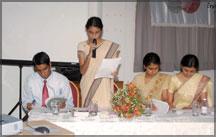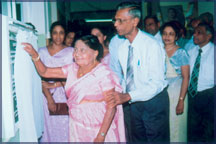|
DAILY NEWS ONLINE |
|
|
|
OTHER EDITIONS |
|
|
|
|
|
|
|
|
|
OTHER LINKS |
|
|
|
|
|
|
 |
|
Medical students overshadow doctors in debating skillsAT the recently held PGIM debate on setting up of a private medical school to accommodate the large number of students who fail to get admission to the State medical schools due to the area based cut off points, and lack of accommodation in the existing medical schools, the medical student group who took part opposing the idea outshone the four member doctor group comprising two professors and two lecturers in debating skills.
The debate was held on this hot topic as part of the PGIM's Silver Jubilee celebrations. In the medical student group which comprised one male and three female students, the females outshone everybody, presenting their points sharply with vigour displaying their debating skills to the admiration of all present. Their main arguments against the setting up of a private medical school were (a) uncertainty whether they could produce quality doctors, as the private sector projects are primarily profit-oriented.
(b) How could they teach forensic medicine, as the training has to be done in State hospitals for which they (private medical schools) would have no access. TB and Community Medicine too they would not be able to teach the students properly. They argued that the State would not be able to properly supervise and regularise the private medical schools owing to the corruption and bribery that is found in almost all sectors in the society. When the proposition doctor group pointed out how successfully the country's second private medical school - the North Colombo Medical School (which was later vested in the State) was launched; and how brilliantly most of them have come up in the profession and serving the people here and abroad. The students threw the ball back at them, saying "what is the degree you wanted to give your students? It was our degree MBBS Colombo University. That is why we vehemently opposed it then and wanted it taken over by the government. You were also using some of the facilities in the Ragama State Hospital. That itself shows that on your own you would not have been able to produce a quality doctor. A doctor in the proposition group interjecting: You are wrong there. It was the UGC who wanted us get ourselves attached to one of the universities here, and the Colombo university representative who was there at the meeting who said we could give their degree. The proposition groups main argument was that complete State monopoly in anything was bad, except in a few areas life defence; but certainly not in medical education. Only, as it is happening today in the education field. The groups view on bribery and corruption was that in a free society it is difficult to eliminate it. Prof. Carlo Fonseka who was winding up for the proposition asks from the chair: How much more time do I have. The Chair: One minute, but I will give you another minute. Prof. Fonseka: Turning to the students. There you see corruption from the top. It looks that you all are the only incorrupt lot in society. The entire crowd burst out laughing. Prof. Colvin in the Chair: Refers to a case in England where once a prominent person was brought before Court with allegation of bribery from one side in deciding an issue. The accused admitting taking the bribe had said that he took a bribe from the other side too, so that his decision was independent and not favoured to one side or the other. He also observed, that the students debated excellently and the other side was also not too bad. Both sides gave a lot of matter for thought. He felt the issue should be deliberated upon further by the medical profession as a whole, and a decision taken. With regard to private medical school the need was there and it has to be done with proper controlling mechanisms and regulations. The two sides who took part in the debate were: Proposition - Prof. Carlo Fonseka, Dr. Dennis J. Aloysius, Prof. Benita Stephen, Dr. S. Kariyawasam. Opposition - Dr. Dulika Sumathipala, Tamara Hapuarachchi, Charith Horadagoda and Roshini Weerasiri. Prof. Colvin Goonaratna chaired the debate. Woman philanthropist builds Rs. 2.4m NIC unit in Kandy Teaching HospitalLAST week Dr. S. C. Wickremesinghe Neonatologist Kandy Teaching Hospital highly commended the generosity and humanistic feelings of a Kandy philanthropist Leslin Narampanawa who completely funded the building of a two-roomed NIC unit in the hospital costing over Rs. 2.4 million.
Dr. Wickremesinghe was speaking at a simple ceremony held at the opening of the unit which now enables the doctor to care for about eight more premature babies, who need hospitalised intensive care of about 3 to 4 months before discharging. She said Ms Narampanawa who heard about this need for an additional NIC from one of her relations Dr. W. J. Arambewala readily consented to meet the entire cost of the unit, and did it. She said, she needed some more facilities for this unit, which is the only unit to care for premature babies in the Kandy district, and wished more people like Ms Narampanawa would come forward to help her. Kamalika Abeyratne got World Bank funds to fight AIDSPROF. SANATH Lamabadusuriya Dean and Senior Professor of Paediatrics of the Colombo Medical Faculty writing in the Sri Lanka Journal of Child Health on the life of late Paediatrician Dr. Kamalika Abeyratne who died of AIDS recently says, "she fought hard and finally won the right to provide funds for treatment of AIDS through the World Bank". He goes on to say "late Dr. Kamalika Abeyratne who passed away a few months ago after battling a long drawn out illness AIDS with tremendous courage, in the early 1980s led a group of doctors regularly held clinics to remote areas where new settlements had sprung up as the Mahaweli Scheme flourished. "When the Eelam war broke out she continued to visit border villages to look into the health needs of children. A few years later she went to Saudi Arabia to join her husband who was working there and returned 4 years later. After returning to Sri Lanka, it is quite ironical that she met with that fateful accident whilst on her way to the deep south to conduct a health camp for the benefit of poor children. It is that accident which necessitated a blood transfusion which unfortunately introduced the AIDs virus. Many others would have resigned to their fate quietly in the twilight of their lives. Not Kamalika! She launched a long battle for the sake of fellow victims. She went public and started a campaign through various NGO's to minimise the social stigma associated with the disease. She fought hard and finally won the right to provide funds for treatment of AIDS patients through the World Bank. Michael, her children, grand children and other close relations and friends could all feel very proud of what Kamalika gave back to the country and its people both as a medical professional and a crusader for victims of AIDS. May she attain the supreme bliss of Nirvana! Dietry fibre and blood pressure
|
||||
|
|
 In the PGIM debate on private medical schools issue:
In the PGIM debate on private medical schools issue:




